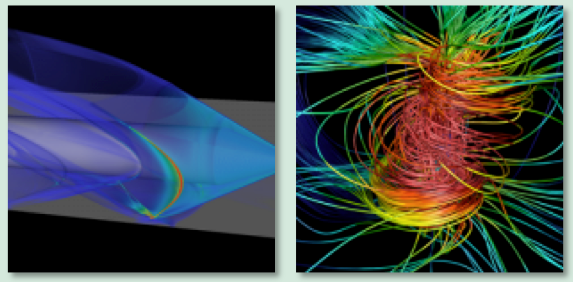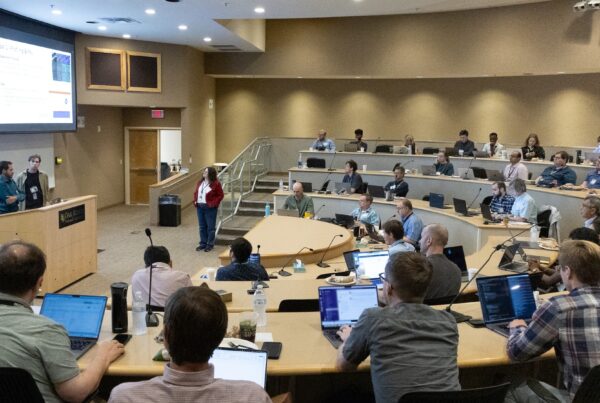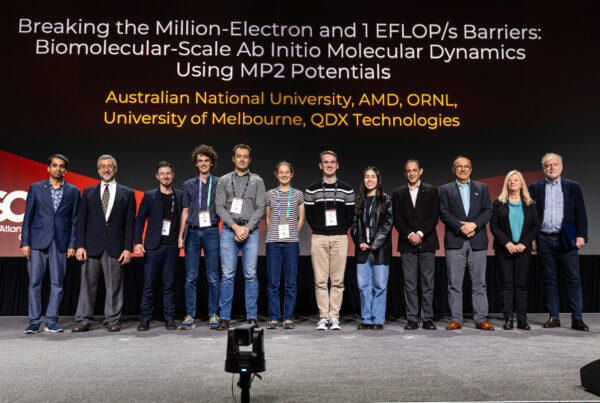Pugmire and Matheson Win Five Peer and Juried Awards
Three animations created by Oak Ridge National Laboratory (ORNL) computer visualization specialists Dave Pugmire and Mike Matheson won big at the Scientific Discovery through Advanced Computing (SciDAC) Electronic Visualization Night, held on July 12 in Denver, Colorado. The ORNL duo won a total of three OASCRs (Office of Advanced Scientific Computing Research) and two juried “Best” places/designations.
Award Winning Visualizations (Click to view animations)
[vimeogallery][/vimeogallery]
“These entries were chosen based on our successful interactions with customers, the best of our normal job—helping scientists understand their large data sets,” said Sean Ahern, Oak Ridge Laboratory Computing Facility (OLCF) visualization task leader. “Visualization enables scientific discovery.”
Pugmire received People’s Choice OASCR statuettes for his two movies on vector field analysis. His visualization, titled “Magnetic Field Outflows from Active Galactic Nuclei,” was also judged “Best Visual Presentation” in the juried competition, which rewarded Pugmire with an iPad. The simulation was run on the University of Tennessee’s supercomputer Kraken, managed by the National Institute for Computational Sciences and located at ORNL, and used the FLASH code to analyze several different models of magnetic field generation that can then be compared to observational data. The visualizations of magnetic fields were done on Lens, a 32-node Linux cluster dedicated to data analysis and high-end visualization, and Frost, an SGI Altix ICE 8200 cluster, using two visualization tools, VisIt and Blender.
Matheson’s entry, “Shock Wave/Turbulent Boundary Layer Interactions,” which showed complex fluid flows, received both the People’s Choice OASCR and the juried “Best Presentation of Information” award, earning Matheson the OASCR statuette and an iPad. Pugmire’s second OASCR winner, “Magnetic Fields in Core-Collapse Supernovae,” depicting the magnetic field inside the shock surface of a supernova, was created using the GenASIS code on the OLCF’s petascale supercomputer, Jaguar.

The OLCF’s Mike Matheson won for his visualization of “Shock Wave/Turbulent Boundary Layer interactions” (left) and Dave Pugmire of the OLCF won for his visualization, “Magnetic Field Outflows from Active Galactic Nuclei” (right).
“The dramatic growth in available computing resources has resulted in a corresponding increase in data produced by scientific simulation codes,” said Eirik Endeve, a computational astrophysicist and collaborator in the supernova project. “The analysis of this data poses a challenge for researchers. Visualization plays an invaluable role, both in the process of understanding and communicating the output produced by our simulation codes.”
The active galactic nuclei project team members, along with Pugmire, are Paul Sutter, Paul Ricker, Hsiang-Yi Yang, and Gary Foreman of the University of Illinois at Urbana-Champaign. By depicting the streamline—the path a particle takes in the magnetic flow—researchers can visualize the magnetic field after six billion years of evolution.
On the supernovae project, Pugmire worked with a team of ORNL scientists—Anthony Mezzacappa, Eirik Endeve, Christian Cardall, and Reuben Budiardja—to look at the magnetic field inside the shock surface of the core-collapse supernovae.
“The magnetic field is very important in understanding the behavior of the supernova,” said Pugmire. His animation shows the turbulent, complicated streamlines of the magnetic field.
Matheson worked with “Shock Wave” collaborators Allan D. Grosvenor of Ramgen Power Systems, LLC, and Alexander A. Zheltovodov of the Khristianovich Institute of Theoretical and Applied Mechanics in Novosibirsk, Russia. “Effective use of 3-D visualization, based on high resolution CFD, gives us much better insight into the nature of the aerodynamic losses, so that we may determine effective design changes to address them,” said Ramgen’s Grosvenor. “The powerful and sophisticated OLCF computing and visualization capabilities are providing Ramgen with a major advantage in the numerical analysis of shock wave / boundary layer interaction. This in turn enables Ramgen to understand phenomena, and test unique design options in a manner that was previously impossible.” Jaguar’s ability to utilize VisIt (a scalable visualization package) is a key advantage for analyzing very large simulation results.
A complete list of the 2011 SciDAC Electronic Visualization Night winners is listed at https://events.cels.anl.gov/scidac11/visualization-night/visualization-night-winners/.
The Viz night competition is an annual event at the SciDAC conferences, with conference attendees voting on the submissions and OASCR statuettes going to the top ten vote-getters. A new competition category was added this year, with three judges considering all submissions, before awarding two “Best” place prizes. Matheson and Pugmire were also on the ORNL team with Sean Ahern and Jamison Daniel that won an OASCR last year for their movie, “Clean Energy for the Future with the ITER Reactor.” –by Sandra Allen McLean





